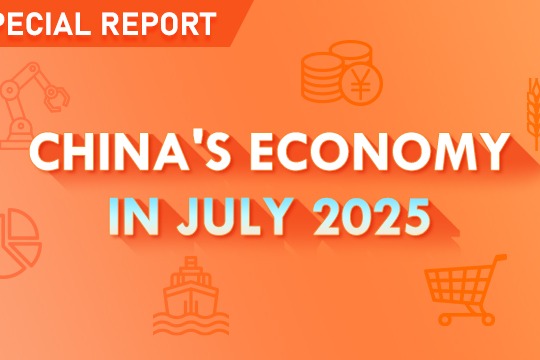Hydrogen to play bigger role in green transition


Hydrogen is expected to play a much larger role in China's decarbonization, especially in industries like steelmaking and aviation, where there are few clean energy alternatives, analysts said.
While the country is stepping up development of renewable energy, hydrogen could help cope with the intermittent nature of renewables, as the excessive supplies of renewable power can be used for electrolysis to produce green hydrogen, which can be utilized later to generate electricity, said Ivy Yin, energy transition analyst at S&P Global Platts.
According to S&P Global Platts Analytics, decarbonization in industrial production is highlighted in China, as the nation produces more than half of the world's steel and cement. Emissions from these products can be reduced dramatically with electrolysis hydrogen, provided the input of electricity is from renewables.
As the world's largest pure hydrogen user, China consumes 14.6 million metric tons per year, making up 20 percent of global demand. Over 95 percent of hydrogen is consumed in oil refining and ammonia synthesis, S&P Global Platts said.
The increasing application of hydrogen in these sectors could have a positive influence on carbon emissions reductions as China has a large refining sector and is also the world's leading ammonia producer at nearly 48 million tons per year-a level representing 25 percent of global supply.
Yin believes China is likely to maximize its efforts to facilitate the production and supply of hydrogen, such as leveraging renewables in North China and Northwest China for massive wind and solar power projects, among which the first batches in the areas comprising 100 gigawatts of wind and solar energy have already launched operations.
"Hydrogen can also be transported across long distances flexibly, which is difficult for renewable energy due to great challenges associated with inter-regional power transmission," said Yin.
"Heavy transportation like trucking and public transit buses is also a potential market for fuel cell electric vehicles."
Luo Zuoxian, head of intelligence and research at the Sinopec Economics and Development Research Institute, said hydrogen will likely play a key role in cutting emissions in sectors like steelmaking, heavy-duty trucks, shipping and cement.
It is believed the government will come up with a more detailed development plan for the hydrogen energy industry soon covering hydrogen production, transportation and consumption, Luo said.
The energy vehicle development plan drafted by the Ministry of Industry and Information Technology said China aims to have 1 million hydrogen fuel cell vehicles on the road by 2030, with at least 1,000 hydrogen refueling stations.
Many State-owned enterprises, including China Petroleum and Chemical Corp and State Power Investment Corp Ltd, have proposed ambitious hydrogen strategies.
SPIC started a demonstration project in the Tibet autonomous region in November, which focused on using hydrogen to overcome the issue of the intermittence of renewable-based power.
China Petroleum and Chemical Corp, also known as Sinopec, announced an investment plan of $4.6 billion in the hydrogen sector through 2025, aiming to boost its annual hydrogen production capacity to 500,000 tons by 2025.
Sinopec has also started construction of a major green hydrogen project in the Xinjiang Uygur autonomous region in November. The project is expected to produce 20,000 tons of green hydrogen annually after being put into operation in 2023.
Alan Hayes, an analyst with S&P Global Platts, said the project is an important test case which includes the development of renewable power generation, new hydrogen production and new hydrogen storage, and can replace high carbon-based hydrogen with a low-carbon choice at the consumer end.
"There are not many other projects that can include the full hydrogen production and consumption chain," Hayes said. One of the challenges for all low carbon hydrogen projects around the world will be the high production costs due to current production pathways. The key to gaining more prominence for low carbon hydrogen projects based on electrolysis in the market is to widen access to low-cost electricity from renewable sources, which can also help them maintain regional cost competitiveness, he said.
Yin said China's hydrogen electrolyzers are already much cheaper than overseas suppliers and the country expects to become a key global hydrogen equipment supplier by bringing down manufacturing costs, similar to what the country has done to dominate global solar panel production.
On the other hand, hydrogen penetration into new markets still requires massive investment in "ecosystem" infrastructure, including hydrogen transportation, storage and delivery, as well as renewable electricity generation.
These challenges are not unique to China, said S&P Global Platts Analytics. Carbon neutral hydrogen, along with renewables and nuclear energy, will need to further grow its share in China's electricity mix to displace coal and gas, said Yin.
Domestic cities are laying out plans to tap into the hydrogen sector. The nation's capital aims to have over 10,000 fuel cell vehicles on the road and 37 hydrogen filling stations by 2025, part of its ambitious plan to develop the hydrogen energy industry.
Shanghai is aiming to lead development of the country's hydrogen industry with 10,000 hydrogen cars and more than 30 hydrogen stations by 2023. Shanxi province, a traditional base for coal mining, also vowed to become a national hub for the hydrogen industry, taking the development of hydrogen as part of its energy revolution.




































